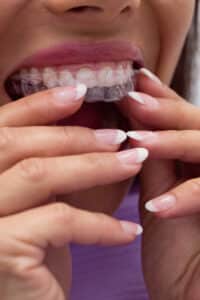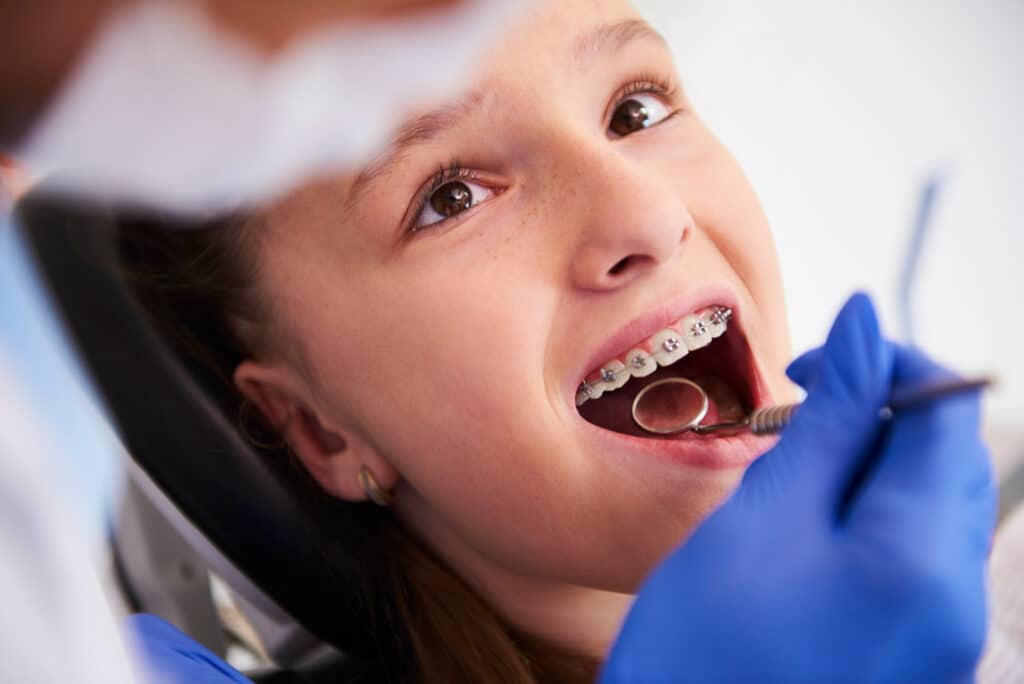Invisalign vs. Traditional Braces: Which is Right for You?
When it comes to perfecting your smile, you have more options than ever before. Two of the most popular choices are Invisalign and traditional braces. Both have their advantages and disadvantages, making it essential to understand what each option entails to make an informed decision. This guide will help you weigh the pros and cons of each method to determine which is right for you.
Understanding the Basics
Before diving into the specifics, let’s clarify what each treatment involves. Understanding the fundamental differences between Invisalign and traditional braces can help you make an informed choice that aligns with your needs and lifestyle.
What is Invisalign?
Invisalign is a modern approach to orthodontic treatment, using a series of custom-made, clear plastic aligners to gradually shift your teeth into place. These aligners are removable and nearly invisible, making them a popular choice for adults and teenagers. The treatment begins with a consultation where a digital scan of your teeth is taken to create a personalized treatment plan.
The aligners are replaced every one to two weeks, each new set bringing you closer to your desired smile. Because the aligners are removable, maintaining oral hygiene and enjoying your favorite foods is much easier compared to traditional braces. However, the success of Invisalign depends significantly on the user’s commitment to wearing the aligners for the recommended 20-22 hours per day.
What are Traditional Braces?
Traditional braces involve metal brackets and wires affixed to the teeth, which are periodically tightened by an orthodontist to shift the teeth into the desired position. They are highly effective and have been the standard in orthodontic treatment for decades. Traditional braces are suitable for correcting a wide range of dental issues, from minor alignment problems to more complex orthodontic cases.
The components of traditional braces have evolved over time, with options now available in ceramic and clear materials that make them less noticeable. Despite these advancements, traditional braces still require regular visits to the orthodontist for adjustments, which can be time-consuming. Additionally, maintaining oral hygiene can be more challenging due to the fixed nature of the braces.

Benefits of Invisalign
Aesthetic Appeal
One of the most significant advantages of Invisalign is its aesthetic appeal. The clear aligners are virtually invisible, making them an excellent option for those who may feel self-conscious about wearing traditional braces. Whether you are in a professional setting or attending social events, Invisalign allows you to straighten your teeth discreetly.
This aesthetic advantage makes Invisalign particularly appealing to adults and older teenagers who might be concerned about the appearance of metal braces. The ability to remove the aligners for special occasions or important meetings adds to their appeal, providing flexibility that traditional braces cannot offer.
Comfort and Convenience
Invisalign aligners are made from smooth plastic, which can be more comfortable than the metal wires and brackets of traditional braces. Additionally, the aligners are removable, allowing you to eat, brush, and floss with ease. This reduces the risk of irritation to the gums and cheeks, which is a common complaint among traditional braces users.
The convenience of being able to remove the aligners also means you can maintain your regular dental hygiene routine without any special tools. This can significantly reduce the risk of cavities and gum disease during the treatment period. However, it’s crucial to clean the aligners regularly to prevent any buildup of bacteria.
Fewer Orthodontic Visits
With Invisalign, you’ll generally need fewer visits to the orthodontist compared to traditional braces. The treatment plan is mapped out using advanced 3D imaging technology, which allows for fewer adjustments and check-ups. This can be particularly beneficial for individuals with busy schedules or those who live far from their orthodontist.
The fewer visits are possible because the aligners are designed to move your teeth gradually and predictably, based on the initial treatment plan. However, it’s still important to have periodic check-ups to ensure everything is progressing as planned and to receive new sets of aligners.
Benefits of Traditional Braces
Effectiveness
Traditional braces are highly effective for a wide range of orthodontic issues, including complex cases that may not be suitable for Invisalign. They offer precise control over tooth movement, making them a reliable option for comprehensive treatment. Braces can correct severe misalignments, overcrowding, and bite issues more efficiently than Invisalign in many cases.
The fixed nature of traditional braces means that they are continuously working to move your teeth into the desired position. This constant pressure can result in faster and more predictable results for complex cases, making them a trusted choice for many orthodontists.
Predictable Results
Because traditional braces have been used for decades, there is a wealth of clinical data supporting their effectiveness. You can be confident that they will deliver predictable and consistent results. The tried-and-true nature of traditional braces means that orthodontists have extensive experience in managing and adjusting them to achieve optimal outcomes.
The predictability of traditional braces is one of their most significant advantages. With numerous studies and years of practical application, the success rate of traditional braces is well-documented, providing peace of mind for patients undergoing treatment.
No Compliance Issues
Since traditional braces are fixed to your teeth, there are no compliance issues. You won’t have to worry about forgetting to wear your aligners or losing them, which can be a concern with Invisalign. This makes traditional braces a more suitable option for younger patients or those who may struggle with the discipline required for Invisalign.
The fixed nature of braces ensures that the treatment is continuous and uninterrupted, which can lead to more consistent progress. This can be particularly advantageous for individuals who may not be as diligent in following the guidelines required for removable aligners.
Cost Considerations
Traditional Braces vs. Invisalign Cost
When it comes to cost, both Invisalign and traditional braces can vary widely based on the complexity of the case and the geographical location. Generally, traditional braces tend to be less expensive than Invisalign. However, the cost can be influenced by various factors, including the duration of the treatment and the specific requirements of your orthodontic needs.
- Invisalign: The cost can range from $3,000 to $8,000. This higher cost is often due to the advanced technology and materials used in creating the custom aligners. Additionally, the convenience and aesthetic benefits contribute to the overall price.
- Traditional Braces: The cost can range from $2,500 to $7,500. Traditional braces can be more affordable, especially if you opt for metal brackets instead of ceramic or clear options.
Insurance may cover part of the cost for both options, so it’s essential to check with your provider. Some dental insurance plans offer coverage for orthodontic treatments, which can significantly reduce out-of-pocket expenses. Additionally, many orthodontists provide flexible payment plans to make treatment more accessible.
Treatment Time
Invisalign Treatment Time
Invisalign treatment typically takes about 12 to 18 months, but this can vary based on the complexity of the case and how diligent you are in wearing your aligners for the recommended 20-22 hours per day. The treatment duration can be shorter for minor corrections or longer for more complex cases.
The ability to see progress through the series of aligners can be motivating, helping you stay committed to wearing them as required. Regular check-ups with your orthodontist will ensure that the treatment is on track and that any necessary adjustments are made promptly.
Traditional Braces Treatment Time
Traditional braces usually require a treatment time of 18 to 24 months. However, complex cases can take longer to correct. The fixed nature of traditional braces allows for continuous pressure on the teeth, which can sometimes result in faster movement for certain orthodontic issues.
The treatment duration can be influenced by various factors, including the severity of the dental issues being addressed and the patient’s response to the treatment. Regular adjustments by the orthodontist are necessary to ensure that the braces are working effectively and to make any necessary modifications.
Maintenance and Hygiene
Invisalign Maintenance
Maintaining Invisalign aligners is relatively straightforward. They need to be cleaned regularly with a toothbrush and lukewarm water. You should also brush and floss your teeth after every meal before putting the aligners back in. This helps prevent any food particles from getting trapped between your teeth and the aligners, reducing the risk of cavities and gum disease.
For optimal results, it’s essential to keep the aligners clean and clear of any buildup. Specialized cleaning crystals are also available for a more thorough cleaning process. Consistent maintenance will ensure that the aligners remain invisible and effective throughout the treatment period.
Traditional Braces Maintenance
Maintaining traditional braces can be more challenging. Food particles can get stuck in the brackets and wires, requiring diligent brushing and flossing to prevent cavities and gum disease. Special tools like interdental brushes and water flossers can be helpful in keeping your braces clean.
Regular dental check-ups are crucial to monitor oral health during the treatment period. Your orthodontist may recommend specific oral hygiene practices and products to help you maintain a clean and healthy mouth while wearing braces. Despite the challenges, proper maintenance is essential for achieving the best possible results.
Lifestyle Impact
Eating and Drinking
With Invisalign, you can remove the aligners when you eat and drink, allowing you to enjoy your favorite foods without restrictions. However, you must clean your teeth and the aligners before putting them back in. This flexibility makes Invisalign a more convenient option for individuals who don’t want to give up certain foods during their treatment.
Traditional braces, on the other hand, come with dietary restrictions. Hard, sticky, or chewy foods can damage the brackets and wires, requiring repairs and extending the treatment time. Being mindful of your diet can help prevent any complications and ensure a smoother treatment process.
Activities and Appearance
For those concerned about appearance, Invisalign offers a discreet option. Traditional braces can be more noticeable, which might be a concern for some people. Invisalign aligners can also be removed for special occasions or activities, making them more versatile.
Traditional braces, while less discreet, have come a long way in terms of aesthetics. Options like ceramic braces or clear brackets make them less noticeable. However, for individuals who prioritize minimal visibility, Invisalign remains the preferred choice.
Potential Drawbacks
Invisalign Drawbacks
- Compliance: Since Invisalign aligners are removable, they require discipline to wear them for the recommended amount of time each day. Failure to do so can prolong the treatment duration and affect the final results.
- Limitations: Invisalign may not be suitable for more complex orthodontic issues. Severe misalignments or bite problems may require the more robust capabilities of traditional braces.
Despite these drawbacks, many find the benefits of Invisalign, such as its aesthetic appeal and comfort, to outweigh the potential downsides. Consulting with an orthodontist will help determine if Invisalign is a viable option for your specific needs.
Traditional Braces Drawbacks
- Aesthetic Concerns: Traditional braces are more noticeable, which can be a concern for some individuals. This visibility can impact self-esteem, especially in social or professional settings.
- Discomfort: The metal brackets and wires can cause discomfort and irritation, especially after adjustments. This can lead to soreness and the need for orthodontic wax to prevent irritation.
While traditional braces are highly effective, the potential for discomfort and aesthetic concerns can be significant drawbacks. However, for those with complex orthodontic issues, the reliability and effectiveness of traditional braces often make them the better choice.
Final Thoughts
Choosing between Invisalign and traditional braces is a significant decision that depends on various factors, including the complexity of your orthodontic issues, your lifestyle, and your budget. Both options have their pros and cons, making it essential to consult with an orthodontist to determine the best treatment plan for your needs.
In conclusion, whether you opt for Invisalign or traditional braces, the ultimate goal is to achieve a healthy, beautiful smile. With the right information and professional guidance, you can make an informed decision that aligns with your dental health goals and lifestyle. Remember, the journey to a perfect smile is a personal one, and the best choice is the one that fits your unique circumstances.
Get Started on Your Journey to a Perfect Smile
If you’re ready to explore your orthodontic options and find the best solution for your dental needs, contact Legacy Dental in Boynton Beach, FL, today! Our experienced team is dedicated to helping you achieve a beautiful, healthy smile tailored to your lifestyle. Whether you’re considering Invisalign or traditional braces, we’re here to guide you through the process and answer any questions you may have. Don’t wait—schedule your consultation now and take the first step toward transforming your smile!



